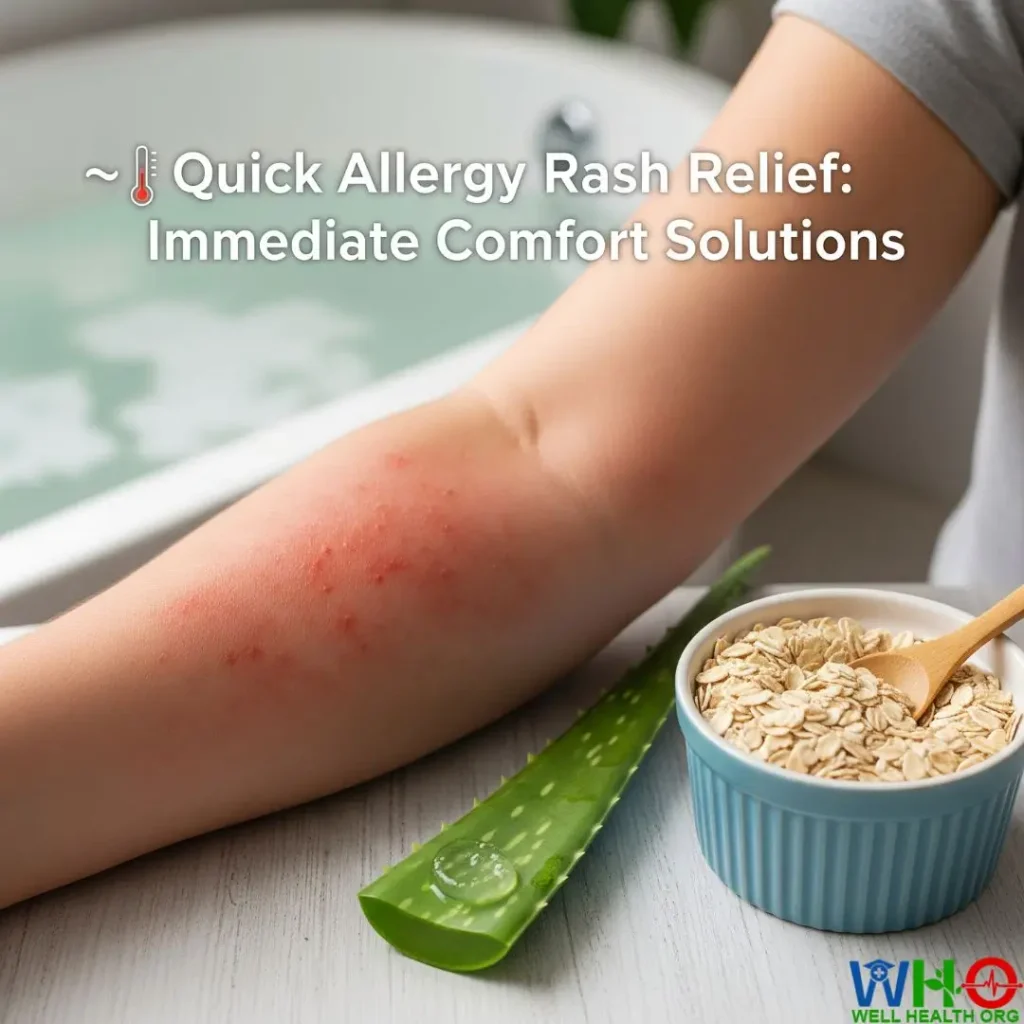The sudden appearance of a skin rash—characterized by intense itching, fiery redness, or angry, raised bumps—is universally alarming and deeply uncomfortable. Allergy rashes are a remarkably common manifestation of the immune system’s overreaction to countless everyday substances, ranging from microscopic environmental allergens like pollen to chemicals lurking in your new laundry detergent. While severe reactions necessitate professional medical intervention, the vast majority of mild to moderate allergy-induced skin irritation can be effectively, safely, and gently managed right from the comfort of your home.
- 🔎 What Exactly is an Allergy Rash? Decoding the Immune Response
- Common Allergy Triggers that Attack the Skin
- 🧐 Identifying Your Specific Allergy Rash
- 1. Contact Dermatitis
- 2. Hives (Urticaria)
- 3. Eczema (Atopic Dermatitis)
- 🌡️ Quick Allergy Rash Relief: Immediate Comfort Solutions
- ❄️ The Power of Cold Therapy (Cool Compresses)
- 🛁 The Calming Sanctuary of Oatmeal Baths
- 🌿 Natural Home Remedies: Targeting Inflammation and Dryness
- 🌵 1. Aloe Vera: The Cooling Anti-Inflammatory Gel
- 🥥 2. Virgin Coconut Oil: Barrier Repair and Antimicrobial Action
- 🌼 3. Chamomile Compress: Antiseptic and Calming
- 🍽️ The Internal Approach: Dietary Support for Skin Health
- Identifying and Eliminating Food Triggers
- Incorporating Anti-Inflammatory Foods
- 🛡️ How to Prevent Future Rashes: Long-Term Skin Health
- 🎯 1. Be a Detective: Identify and Avoid Specific Triggers
- 👚 2. Dress for Skin Comfort
- 💧 3. Maintain an Impeccable Skin Barrier
- 🚨 When to See a Doctor: Red Flags You Must Not Ignore
- 🌟 Take Control of Your Skin’s Comfort
- ❓ Frequently Asked Questions (FAQs) on Home Remedies for Allergy Rashes
- 1. What is the fastest way to stop the itching from an allergy rash?
- 2. Can I use regular food-grade oatmeal instead of colloidal oatmeal in a bath?
- 3. Is it safe to put coconut oil on all types of allergy rashes?
- 4. Should I use hot or cold compresses for a rash?
- 5. When should I definitely stop home treatment and see a doctor?
- 🌟 Conclusion: Take Control of Your Skin’s Comfort
This comprehensive guide is built on the principles of Expertise, Experience, Authoritativeness, and Trustworthiness (E-E-A-T), designed to empower you with the knowledge needed to manage and prevent these disruptive skin reactions. We will systematically explore various home remedies for allergy rashes, covering immediate relief techniques, deeply soothing natural ingredients, and proactive, long-term prevention strategies. Understanding your rash, soothing the flare-up with evidence-based natural solutions, and knowing precisely when to seek expert medical care are the cornerstones of reclaiming your skin health.
🔎 What Exactly is an Allergy Rash? Decoding the Immune Response
An allergy rash is essentially an inflammatory battleground created on your skin when your immune system encounters a substance it mistakenly identifies as a threat. This harmless substance, termed an allergen, triggers a complex internal chain reaction, most notably the rapid release of a chemical mediator called histamine. Histamine is responsible for the classic symptoms of an allergic reaction: it increases blood flow to the area (causing redness and warmth), makes blood vessels leak fluid (causing swelling), and stimulates nerve endings (causing intense itching).

Common Allergy Triggers that Attack the Skin
The causes of allergy rashes are incredibly diverse, spanning environmental, ingestive, and topical exposures:
- Environmental Culprits: Airborne particles like pollen, dust mites, and pet dander can sometimes land on the skin or be inhaled, causing systemic histamine release that manifests as hives or worsens eczema.
- Topical Contactants (Contact Dermatitis): Direct physical contact is a major factor. Well-known culprits include:
- Plants: Poison ivy, poison oak, and poison sumac (due to the oil urushiol).
- Metals: Nickel (commonly found in costume jewelry, belt buckles, and watch straps).
- Chemicals: Latex, cleaning supplies, and chemicals in dyes or certain fabrics.
- Ingested Allergens: Foods (peanuts, tree nuts, shellfish, eggs, dairy, soy, wheat/gluten) or Medications (especially antibiotics like penicillin, or NSAIDs) can trigger widespread systemic reactions, often appearing as hives or a generalized maculopapular rash.
- Skincare and Cosmetics: Fragrances, parabens, preservatives, and essential oils in lotions, soaps, shampoos, and makeup are frequent instigators of localized contact dermatitis.
🧐 Identifying Your Specific Allergy Rash
Effective treatment hinges on accurate identification. While only a dermatologist can provide a definitive diagnosis, understanding the three most common types of allergy-related rashes can guide your choice of home remedy.

1. Contact Dermatitis
- Appearance: This rash is limited to the exact site where the allergen touched the skin. It typically presents as red, intensely itchy bumps or patches.
- Evolution: In severe cases (like poison ivy exposure), it can develop into weeping blisters or, if chronic, become scaly, cracked, and dry (lichenified).
- Mechanism: It is the result of direct topical exposure, with the immune system recognizing and reacting to the substance it touched.
2. Hives (Urticaria)
- Appearance: Characterized by distinctive raised, pink or red welts (wheals) that are profoundly itchy.
- Nature: Hives are highly dynamic—they can appear quickly, fade within hours, and then reappear in a completely different location on the body. They vary widely in size and shape.
- Mechanism: Hives are usually triggered by a systemic release of histamine, often due to food, medication, or environmental allergens, but sometimes triggered by stress or temperature changes.
3. Eczema (Atopic Dermatitis)
- Appearance: Presents as chronically dry, red, flaky, and intensely itchy patches of skin. It often appears in the creases of the elbows and knees, or on the face and neck.
- Relationship to Allergy: Eczema is a chronic skin condition with a genetic component, but it is often triggered or significantly worsened by exposure to allergens (like dust mites) or irritants (like harsh soaps). Treatment focuses on moisturizing and reducing inflammation.
🌡️ Quick Allergy Rash Relief: Immediate Comfort Solutions
When the itch is driving you to distraction, rapid, non-invasive cooling techniques are your best immediate defense against scratching and further inflammation.

❄️ The Power of Cold Therapy (Cool Compresses)
Applying cold is the most immediate way to mute the skin’s angry response.
- Mechanism: Cold works in two key ways: it constricts the blood vessels (vasoconstriction) near the skin’s surface, which instantly reduces redness and swelling. Secondly, it temporarily numbs the irritated nerve endings, dulling the sensation of itchiness.
- Application: Soak a clean, soft washcloth in cool or slightly cold water. Wring it out and apply it gently to the rash area for 5 to 10 minutes.
- Ice Safety: If using an ice pack, always wrap it in a thin towel to prevent direct contact with the skin, which can cause freezer burn and further irritation.
🛁 The Calming Sanctuary of Oatmeal Baths
For rashes that are widespread or cover large areas of the body (common with hives or systemic drug reactions), a cool bath provides full-body relief.
- The Crucial Temperature Rule: Always use cool or lukewarm water, never hot. Hot water strips the skin of its essential natural oils (lipids and sebum), compromising the skin barrier and worsening dryness, irritation, and itching.
- Colloidal Oatmeal Therapy: For supreme soothing power, add colloidal oatmeal (finely ground oat kernels, Avena sativa) to the bathwater.
- Scientific Basis: Colloidal oatmeal contains natural compounds called avenanthramides, which have documented anti-inflammatory and anti-pruritic (anti-itch) properties. They also create a protective, moisturizing film on the skin.
- Usage: Soak in the colloidal oatmeal bath for 15 to 20 minutes, then gently pat your skin dry (do not rub!) and immediately apply a moisturizer to lock in hydration.
🌿 Natural Home Remedies: Targeting Inflammation and Dryness
Your kitchen and garden hold effective, natural ingredients that can significantly aid the healing process.

🌵 1. Aloe Vera: The Cooling Anti-Inflammatory Gel
Aloe vera has a legendary reputation for soothing inflamed skin, and it is particularly suitable for red, warm, or slightly sunburned-looking rashes.
- Mechanism: The gel is naturally cooling and contains compounds that have potent anti-inflammatory effects. It also promotes skin hydration without feeling heavy or oily.
- Application: Apply pure aloe vera gel directly to the rash. The best source is directly from a freshly cut aloe leaf, as store-bought versions often contain preservatives or alcohol that can irritate sensitive skin. If buying, choose a product with the highest percentage of pure aloe and minimal additives.
🥥 2. Virgin Coconut Oil: Barrier Repair and Antimicrobial Action
Coconut oil is an exceptional natural moisturizer that supports the damaged skin barrier.
- Mechanism: Virgin coconut oil is rich in Lauric Acid, a medium-chain fatty acid with proven antimicrobial properties. While it can soothe dryness and flakiness associated with chronic rashes (like eczema), its primary role here is to provide a protective lipid barrier, helping the skin retain moisture and repel external irritants.
- Application: Apply a thin layer of virgin, unrefined coconut oil to dry, non-weeping patches of rash.
- Caveat: Because coconut oil is a strong moisturizer, it should be avoided on open, weeping, or highly blistered rashes, as trapping moisture can potentially worsen those specific conditions.
🌼 3. Chamomile Compress: Antiseptic and Calming
Chamomile (Matricaria recutita) is celebrated for its sedative qualities, but its benefits extend powerfully to the skin.
- Mechanism: Chamomile contains bisabolol and chamazulene, compounds with significant anti-inflammatory, antioxidant, and mild antiseptic properties. Applied topically, it can calm redness and soothe pain.
- Application: Brew a strong cup of chamomile tea (using two to three tea bags). Let the tea cool completely (you can chill it in the refrigerator). Soak a clean cotton cloth or gauze in the cooled tea and apply it as a soothing compress to the rash area for 10–15 minutes. This is particularly effective for highly reactive skin patches.
🍽️ The Internal Approach: Dietary Support for Skin Health
The condition of your skin is often a reflection of your internal health and inflammatory status. Dietary adjustments can be a powerful long-term strategy.

Identifying and Eliminating Food Triggers
If your rash (especially hives or widespread eczema flares) appears consistently after eating, a food allergy or sensitivity is highly likely.
- Food Diary: Keep a detailed log documenting everything you eat and drink, alongside the time and severity of any rash flare-ups. This systematic approach (Expertise) is the most trustworthy home method for pinpointing potential culprits like common allergens (dairy, soy, nuts, gluten, eggs).
- Elimination: If a pattern emerges, work with a professional allergist or dietitian to safely perform an elimination diet. Never eliminate major food groups long-term without professional guidance.
Incorporating Anti-Inflammatory Foods
Support your body’s defenses by focusing on foods that naturally fight inflammation (Authoritativeness).
- Omega-3 Fatty Acids: These essential fats are powerful anti-inflammatories. Increase consumption of fatty fish (salmon, mackerel, sardines), walnuts, chia seeds, and flaxseeds.
- Antioxidant-Rich Produce: Foods high in antioxidants neutralize the free radicals created by inflammation. Focus on deeply colored berries (blueberries, raspberries), leafy green vegetables (spinach, kale), and vibrant spices like turmeric (which contains the potent anti-inflammatory compound curcumin).
🛡️ How to Prevent Future Rashes: Long-Term Skin Health
Prevention involves diligence in avoiding triggers and strengthening the skin’s natural protective barrier.
🎯 1. Be a Detective: Identify and Avoid Specific Triggers
Once you’ve identified the cause—be it the nickel stud on your jeans, the fragrance in your body wash, or a specific tree pollen—absolute avoidance is the single most effective prevention method.
- Laundry Swap: Switch to fragrance-free, dye-free, and hypoallergenic laundry detergents and fabric softeners.
- Jewelry: Use clear nail polish to coat the underside of nickel-containing metal jewelry that rests against the skin.
- Product Testing: When trying a new cosmetic, perform a patch test on a small, inconspicuous area (like behind the ear or on the inner forearm) for several days before applying it widely (Experience).
👚 2. Dress for Skin Comfort
- Fabric Choices: Opt for loose-fitting garments made from soft, natural, breathable fabrics like 100% cotton.
- Avoid Irritation: Tight clothing can create friction, trap heat and sweat, and exacerbate itching and inflammation, especially in areas prone to chafing (like the inner thighs or under the arms). Wool and synthetic fabrics like nylon can also be irritants for sensitive skin.
💧 3. Maintain an Impeccable Skin Barrier
A robust skin barrier is less permeable to allergens and irritants.
- Regular Moisturizing: Use a gentle, thick, hypoallergenic moisturizer or barrier cream (e.g., one containing ceramides) regularly, especially immediately after bathing when the skin is still damp. This “locks in” the moisture.
- Cooling Storage: Keep your moisturizer in the refrigerator. Applying a cool cream offers an extra layer of anti-itch relief while ensuring deep hydration.
🚨 When to See a Doctor: Red Flags You Must Not Ignore
While home remedies are excellent for supportive care, it is crucial to recognize the signs that a rash requires professional medical evaluation and prescription-strength treatment.
| Situation | Action Required | Explanation |
| No Improvement or Worsening | Consult a Physician (Dermatologist) | If the rash persists beyond a few days, spreads rapidly, or shows no improvement despite consistent home care, professional diagnosis is required. |
| Signs of Infection | Seek Urgent Care | Look for increased warmth, significant swelling, tenderness, streaks of red leading away from the rash (lymphangitis), or the presence of pus. Infected rashes require oral or topical antibiotics. |
| Fever and Systemic Illness | Seek Urgent Medical Care | If the rash is accompanied by a high fever, extreme fatigue, joint pain, or persistent nausea, it could indicate a systemic infection or drug reaction. |
| Signs of Anaphylaxis | Call Emergency Services (911 or Local Equivalent) IMMEDIately | This is a life-threatening medical emergency. Watch for: Difficulty breathing or wheezing, tightness in the throat, swelling of the face, lips, or tongue, rapid or weak pulse, severe dizziness or fainting. |
A doctor can prescribe highly effective prescription treatments such as potent topical steroids or systemic antihistamines, and conduct diagnostic tests (like patch testing or blood work) to accurately pinpoint the specific cause of your allergic reaction, moving you from managing symptoms to preventing the reaction entirely.
🌟 Take Control of Your Skin’s Comfort
Dealing with the relentless cycle of an allergy rash—the itching, the redness, the frustration—can be incredibly taxing. However, you possess the power to effectively manage these symptoms at home. By utilizing the simple, potent relief offered by cool compresses and colloidal oatmeal, integrating natural anti-inflammatory agents like aloe vera and chamomile, and making conscious, therapeutic choices about your diet and environment, you can quickly find the allergy rash relief you need.
Remember the final, crucial step: be attentive to your body’s signals. Listen to the severity of the symptoms, avoid the temptation to scratch, and do not hesitate to seek medical support when the rash is severe, widespread, or shows signs of infection. Empowered with this knowledge, you are well-equipped to soothe the flare-up and restore your skin to its natural, calm, and healthy state.
❓ Frequently Asked Questions (FAQs) on Home Remedies for Allergy Rashes
1. What is the fastest way to stop the itching from an allergy rash?
The fastest way to achieve immediate relief from itching is usually a cool compress or a cool bath with colloidal oatmeal. Cold temperature works by temporarily numbing the nerve endings and constricting blood vessels, which reduces inflammation and dulls the itching sensation quickly.
2. Can I use regular food-grade oatmeal instead of colloidal oatmeal in a bath?
You can, but it is less effective and messier. Colloidal oatmeal is finely ground so it dissolves and disperses evenly in the water, creating a soothing film on the skin. Regular oats will clump and sink. If you only have regular oats, you can grind them into a fine powder yourself using a blender or food processor to achieve a similar, though less refined, effect.
3. Is it safe to put coconut oil on all types of allergy rashes?
No. Coconut oil is best used on dry, flaky, or scaly patches associated with chronic conditions like eczema or the healing phase of contact dermatitis, as it excels at moisturizing and barrier repair. It should be avoided on oozing, weeping, or blistered rashes (like acute poison ivy), as it can trap moisture and potentially worsen the condition or increase the risk of infection.
4. Should I use hot or cold compresses for a rash?
Always use cool or cold compresses. Heat (from hot water or a hot compress) increases circulation and inflammation, which intensifies redness and, crucially, worsens the itching by stripping the skin of its protective oils. Cool temperatures soothe inflammation and reduce the urge to scratch.
5. When should I definitely stop home treatment and see a doctor?
You must seek professional medical attention immediately if you notice signs of a secondary infection (increased warmth, swelling, pus, red streaks leading away from the rash), if you develop a fever, or if you experience signs of a severe systemic reaction (anaphylaxis), such as difficulty breathing, swelling of the face or throat, or dizziness. Additionally, see a doctor if a widespread rash persists for more than a few days without any improvement.
🌟 Conclusion: Take Control of Your Skin’s Comfort
Dealing with the relentless cycle of an allergy rash—the itching, the redness, the frustration—can be incredibly taxing. However, you possess the power to effectively manage these symptoms at home. By utilizing the simple, potent relief offered by cool compresses and colloidal oatmeal, integrating natural anti-inflammatory agents like aloe vera and chamomile, and making conscious, therapeutic choices about your diet and environment, you can quickly find the allergy rash relief you need.
Remember the final, crucial step: be attentive to your body’s signals. Listen to the severity of the symptoms, avoid the temptation to scratch, and do not hesitate to seek medical support when the rash is severe, widespread, or shows signs of infection. Empowered with this knowledge, you are well-equipped to soothe the flare-up and restore your skin to its natural, calm, and healthy state.







